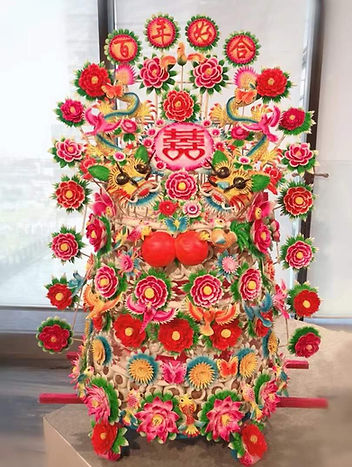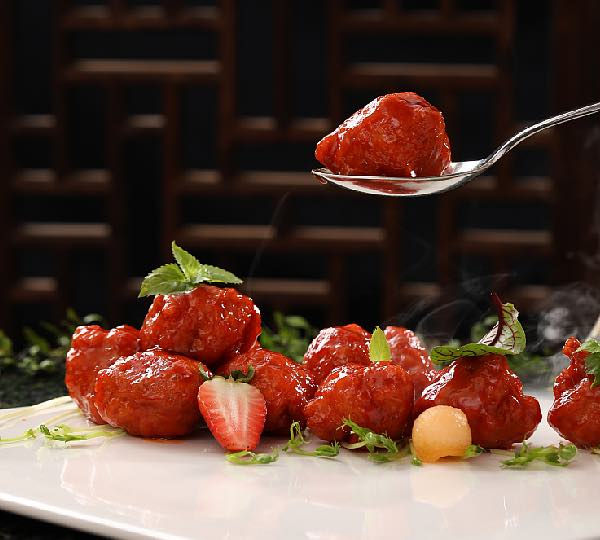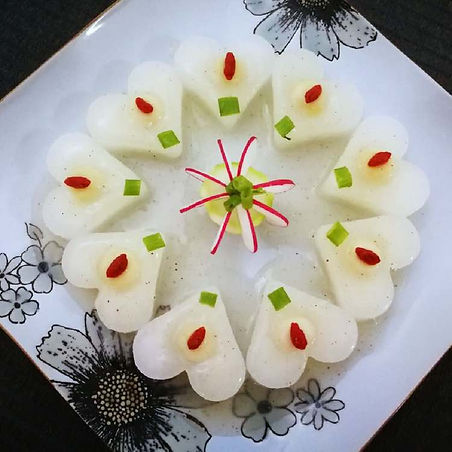Chinese Food Culture — Fun Facts, History, Development, and Etiquette
Chinese food comprises an extensive system that encompasses tens of thousands of dishes throughout history, various cooking methods, symbolic meanings, artsy tableware, and dining etiquette.

Rosewood Food Box with Silver Dinnerwares of the Qing Dynasty (1636 — 1912) — Palace Museum
Chinese Food Culture Facts and History
Distribution and Classification of Chinese Cuisines
Characteristics of Chinese Food Culture
Popular Chinese Foods with Lucky Meanings
Interesting Ways of Naming Chinese Dishes
Basic Cooking Methods of Chinese Food
Artsy Tableware in Chinese Food Culture
A Brief Introduction to Chinese Tea Culture
Chinese Alcohol Drinks Overview
Chinese Food Culture Facts and History
-
The invention of porcelains and cultivation of the Five Grains (soybeans, wheat, broom corn, foxtail millet, and rice) and certain livestock in the Neolithic Era, plus hunting and fishing, formed the most basic diet foundation of the Chinese diet.

Millet Noodle Unearthed from Lajia Site (about 4000 years ago) of Late Neolithic — Qinghai Museum
-
In the Zhou Dynasty (1046 BC — 256 BC), ancient Chinese food culture was officially formed, including dining etiquette, dishes, and tableware that were strictly regulated by one's social status.
The ruling class was also referred to as Meat Eaters because, generally, only they could eat meat during this period.
-
Confucius (551 BC — 479 BC), the founder of Confucianism, concluded an entire system of dining culture, from ingredients, cooking methods, table manners, dining environments, food quality, quantity, and drink.

Bronze Container (Jian) that Could Place Ice Cubes to Cool Wine and Food, Unearthed from Tomb of Marquis Yi of Zeng (about 475 BC — 433 BC) — National Museum of China
-
During the Han Dynasty (202 BC — 220 AD), Zhang Qian opened up the Silk Road and introduced many new types of food, including vegetables, fruits, flavorings, etc.
-
With the scientific development of this era, more cooking methods and food were invented, such as Tofu, vegetable oil, and pastry fermentation.

Royal Banquet of Eastern Han Dynasty (25 — 220) — Grave Mural in Dahuting Tomb in Zhengzhou
-
In the divided Three Kingdoms, Jin, Northern and Southern Dynasties (220 — 589), cultural fusion was an important outcome during this period of wars and contention.
Diary products from nomadic regimes were introduced and flourished in the north, and more fish dishes and rice became popular in the south.
-
In the gold age Tang Dynasty (618 — 907), ingredients and cooking methods thrived.
-
Most flavorings had been discovered and widely used in cooking, except for capsicum.
-
Civilians started to eat three meals every day during this period. Before Tang, ordinary people ate two meals daily, while only nobles could eat thrice.
-
Mutton was the most popular meat, and different types of wheaten food were the main staple food.

Unearthed Wheaten Food and Utensils of the Tang Dynasty — National Museum of China (Photo by Kanjianji)
-
Stir fry food in the iron pot, one of the essential cooking methods of Chinese dishes, was popularized in the Song Dynasty (960 — 1279) when technology extensively reduced the cost of producing iron.
-
In the Song Empire, mutton was mainly eaten by royals and nobles, while civilians could mostly afford pork, chicken, fish, and duck.
-
Morning markets, night markets, professional catering, and takeouts all appeared and flourished during the Song Dynasty to serve exquisite food.



Along the River During the Qingming Festival or Qingming Shang He Tu, Genre Painting of the Capital City (Bianjing or Kaifeng) of the Song Dynasty by Artist Zhang Zeduan (1085 — 1145) — The Palace Museum
-
More crops were introduced in the Ming Dynasty (1368 — 1644), such as sweet potatoes, maize, potato, and peanuts, which became the staple food of poor people.
-
Food culture reached its prime during the Ming (1368 — 1644) and the Qing (1636 — 1912) dynasties when previous cuisines were further developed and more minority cuisines were included.
-
Today's Eight Chinese Cuisines were officially formed during the Qing Dynasty.

Chinese Dessert Bean Cakes (Dou Gao), Picture from Lingchuan Meishi.
Distribution and Classification of Chinese Cuisines
Eight Cuisines
Because of the geographical, climatic, and historical differences, during the Qing Dynasty (1636 — 1912), the Eight Cuisines of China were formed:
Shandong Cuisine, Zhejiang Cuisine, Guangdong Cuisine, Hunan Cuisine, Sichuan Cuisine, Anhui Cuisine, Jiangsu Cuisine, and Fujian Cuisine.
Till today, this is still the primary classification of Chinese Cuisine.
However, many people feel this classification is partial and incomplete and doesn't include many delicacies from other places in China.

Representative Dishes of the Eight Chinese Cuisines, Picture from Xin Shuishui.
Sacrificial Food
In ancient history, sacrifice and worship ceremonies to heaven, earth, immortals, and ancestors, were significant rites of an empire.
Hence, ritual food, drink, and wares had strict regulations based on one's social status and dynasty.
Today, offering ceremonial food to ancestors, deities, and religious temples on important days is still an essential rite for many Chinese people.

Ritual Bronze Tripod of the Zhou Dynasty (1046 BC — 256 BC) Used to Place Food — Luoyang Museum (Photo by Dongmaiying)
Ceremonial Food
In the lifetime of a person, many important days are worth celebrating.
Specific types of dishes are provided in different ceremonies, following traditions and customs, from Birth Celebrations and Coming of Age Ceremonies to weddings, birthdays, and celebrations of one's success in the Imperial Examination.

Steamed Flower Buns in Traditional Weddings of Some Northern Places in China.
Festival Food
People would eat some traditional Chinese food at every Traditional Chinese Festival and each date of 24 Solar Terms.
Such as Zongzi for the Dragon Boat Festival, mooncakes for the Mid-Autumn Festival, dumplings for Winter Solstice, etc.
Read more about Traditional Chinese Festivals and 24 Solar Terms.
Daily Food
The most common food for people daily includes staple foods like rice and wheat, vegetables and fruits, soybeans, meat, dairy products, desserts, tea, alcoholic drinks, and beverages.

Part of Painting (Wen Hui Tu) by Emperor Zhao Ji (1082 — 1135), Presenting the Feast of Intelligent Scholars — Taipei Palace Museum
Characteristics of Chinese Food Culture
-
Highly valued and promoted by royals and scholars.
Many well-established great scholars were great gourmets and frequently noted and described fine dining culture in their poems and articles, such as Confucius, Li Bai, and Su Shi.
-
Related food to Traditional Chinese Medicine.
Based on Yin Yang and Five Elements, food has been used to improve one's health or cure certain diseases, such as Diet Therapy or Medical Diet.
In this theory, all types of food can be divided into Yin (those that make the body cold) and Yang (those that make the body warm) while corresponding to the Five Elements.
Neutralizing the Five Flavors and Yin-Yang is the Essence of Chinese Food Culture and the Medical Diet.
Five Elements in Chinese Culture: Metal, Wood, Water, Fire, Earth
Five Flavors of food: Spicy, Sour, Salty, Bitter, Sweet
Five Main Colors: White, Cyan, Black, Red, Yellow
Five Internal Organs: Lung, Liver, Kidney, Heart, Spleen
Five Sense Organs: Nose, Eye, Ear, Tongue, Mouth
Particular food is good for the corresponding organs and is more beneficial in specific seasons.

-
Seasonal differences.
Because of different situations in the four seasons, diet and cooking methods also are suggested to be adaptable to these changes.
For instance, mild food in spring, light and cold ones in summer, digestive food in autumn, and high-calorie and nutritious dishes in winter.
-
Flavoring and diet diversity regionally.
In a country with a long history and vast territory, diet shows diversity in different regions of China.
In the north, people eat different types of wheat food as staples, while rice is the main staple food for southerners.
As for flavorings of dishes, a fundamental conclusion is salty in the north, sweet in the south, sour in the east, and spicy in the west.
-
No standardized production.
In different Chinese cuisines, one ingredient can be cooked into other flavors. Moreover, different chefs could make the same dish to different tastes.
Therefore, there's no universal standard for a specific dish. Also, it is common that one can only eat certain types of food in a particular place or restaurant.

Fujian Cuisine Dish the Lychee Pork (Lizhi Rou), Picture from Yingzuilou.
-
Hot food in small size for chopsticks.
Generally, the Chinese prefer hot food for all three meals and would cut food before cooking. This way, different ingredients would better influence each other, making it easy for chopsticks to eat.
-
To make the best possible use of food ingredients.
As an agricultural society that had suffered countless famines over thousands of years of long history, ancient Chinese almost tried and tested everything edible and preserved many ways to cook them into tasty dishes, such as offals.
-
Integration of food with symbolic meanings.
Remarkable scholars' love of food throughout history, rich local tradition and folklore, and exceptional creativities of civilians together give many dishes interesting names with beautiful meanings.

Famous Dish of Sichuan Cuisine the Steamed Chinese Cabbage in Supreme Soup (Kaishui Baicai)
Popular Chinese Foods with Lucky Meanings
Here are some popular foods in Chinese culture with lucky meanings because of homophonic pronunciations:
-
Fish: surplus, wealth, and affluence.
-
Chicken: auspiciousness.
-
New Year Cake or Nian Gao: higher, promotion, and more accomplishments.
-
Glutinous Ball or Tang Yuan: reunite and perfect.
-
Celery: diligent.
-
Lettuce: make a fortune.
-
Chinese Cabbage or Bai Cai: auspicious and wealthy.
-
Peanut: have beautiful children soon.
-
Noodle: longevity.
-
Apple: safe and sound.
-
Persimmon: everything going well as one wishes.
-
Peach: represents longevity in ancient mythological folklore.
-
Dumplings: they look like silver or gold ingots in ancient history, representing wealth and fortune.

Gold Ingot Especially Offered to Princes During Tianqi Emperor's Reign (1621 — 1627) — National Museum of China
Interesting Ways of Naming Chinese Dishes
Names of many dishes in Chinese cuisines are classy, beautiful, or very funny, such as Sweet-scented Osmanthus In the Moon, General Crossing Bridge, Buddha Jumping Over the Wall, Tai Ji Vegetable, Jade Heart, etc.
There are some ways to name dishes, which may explain those interesting names:
-
Historical events. Such as "Bawang Bie Ji" to memorize King Xiangyu, one of the strongest forces that overthrew the Qin Dynasty (221 BC — 207 BC).
-
Mythological legends. Such as "Carp Jumping Dragon Gate" based on myths that some carp can incarnate into dragons if they succeed in jumping over the Dragon Gate.

-
Famous people. Such as "Dongpo Pork" which was invented by the great poet and official Su Shi (1037 — 1101), and "Kung Pao Chicken" which was created by official Ding Baozhen (1821 — 1886).
-
Regional specialty. Such as "Beijing Duck" and "Dezhou Braised Chicken".
-
Ingredients or cooking methods. Like "Scrambled Eggs with Tomatoes" and "Braised Eggplant".
-
The looks of the dishes. The "Peacock Flaunting" is a fish dish named after its exquisite layout, and the "Jade Heart" is made of Chinese radish.

Basic Cooking Methods of Chinese Food
Today, there are about 36 main cooking methods in Chinese Cuisine, and some dishes need more than one method.
Some common ones include stir-frying, deep-frying, braising, boiling, steaming, shallow-frying, red stewing, roasting, broiling, grilling, baking, sauteing, simmering, and so on.
Artsy Tableware in Chinese Food Culture
Artifacts of Tableware, Photo by Dongmaiying
A Brief Introduction to Chinese Tea Culture
Everything included in this procedure is the tea culture, from planting to drinking tea.
Whether it is expensive or cheap tea leaves, drinking in fancy rites or simple cups, with or without exquisite refreshments, in an elegant room, on the road, or in beautiful nature, nothing is more important than the taste of the tea.
Chinese Tea Culture can be highly complicated or relatively simple.
It is in many ancient tea books, in countless historical poems and paintings, in many beautiful tea plantations, in Chinese philosophy and religions, and in everyone’s teacups.
People are the culture.
Hence, whenever, whatever, and however they drink, they are all part of the Chinese Tea Culture.

History and Development of Tea in China
Tea was first used in Chinese medicine when the Flame Emperor (Yan Di) discovered it. Since the Han Dynasty (202 BC — 220 AD), tea became a beverage and valuable gift.
Hundreds of years later, tea was an essential daily necessity in China, from royals to civilians, artists to peasants.
This is why tea culture can be complex and easy, exquisite and simple.
Until the Song Dynasty (960 — 1279), tea drinking formed an entire classy theory.
One of the best articles about tea culture during this period was written by Emperor Zhao Ji, a marvelous artist and a horrible monarch with a tragic ending.
Gradually, more tea pieces were cultivated, more tea sets and making skills were invented, and more tasting methods were applied.
Meanwhile, the utilization of tea expanded to almost all important events like the Chinese Wedding.

In the Painting "Wen Hui Tu" by Emperor Zhao Ji (1082 — 1135), People Are Making and Drinking Tea — Taipei Palace Museum
Chinese Alcohol Drinks Overview
Alcohol in Chinese means eternality, possession, and longevity.
The most historical alcohol in China is Millet Wine or Rice Wine, which has been popular for thousands of years.
They were highly appreciated and noted in many poems and historical articles and are more prevalent in southern China.
The Distilled Spirit is relatively new, with a few hundred years of history. Nowadays, people in northern places in China are drinking them more.
Grain, rice, fruit, and flowers can make wine.
Function
In Chinese culture, wine is used to drink, cure disease, cook, and preserve health.
Meanwhile, alcohol has been an important part of all traditional ceremonies, from the grand national rites to people’s big days.

Painting "Lan Ting Xiu Xi" by Wen Huiming (1470 - 1559), Presents An Ancient Way for People to Drink from Cups that are Floating in River — Palace Museum
Basic Table Manners in Chinese Dining
-
Sit in Certain Seat Orders.
-
Not to point at others using chopsticks.
-
Not to stir and pick up in dishes.
-
Only eat from dishes nearby.
-
Not to hit plates and bowls using chopsticks.
-
Not to stick or insert chopsticks in food.
-
Do not eat everything off the plate, which shows that you are complete and the host has provided enough food.
You Might Also Like:
Chinese Dishes — History, Development, Culture, Names, and Facts
Chinese Cuisines — Origin, Classification, Tradition, Culture, and Fact
Shandong/Lu Cuisine — Representative of Northern Food Culture
Jiangsu/Su Cuisine — Sweet, Fresh Series of the Royals
Anhui/Hui Cuisine — Natural, Tasty Series that Disseminated by Diligent Merchants
Fujian/Min Cuisine — Series of Multi-ethnic, Fresh Seafood, and Regional Vegetables
Zhejiang/Zhe Cuisine — Delicate Series with Close Connections to History & Culture
Sichuan/Chuan Cuisine — Popular, Spicy Series with Affluent Flavors
Cantonese/Yue Cuisine — Exquisite Series that Preserves the Primary Flavor
Hunan/Xiang Cuisine — Spicy, Sour Series For People Living in Moist Climate
Diverse and Traditional Beverage
Chinese Alcohol Culture and Toasting Etiquette
Origin, Classification, and Culture of Chinese Tea
Daily Etiquette and Table Manners in Tradition of China
Brief, Comprehensive Introduction to Chinese History
Chinese Patterns — Ultimate Introduction to Origin, History, Meaning, and Culture









